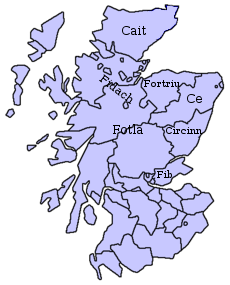Picts facts for kids
The Picts were an ancient group of people who lived in northern and eastern Scotland. We first learn about them in written records from the year AD 297. This was before the Romans fully conquered Britain.
The name 'Pict' comes from the Latin word pictus, which means 'painted'. This might be because they painted or tattooed their bodies. It could also be a name they used for themselves, which the Romans then recorded. The Picts spoke their own language, called Pictish. It was similar to the Brythonic languages spoken by the Britons who lived further south. The Picts were likely the descendants of the Caledonians and other tribes mentioned by Roman historians.
Over time, the Pictish lands in Scotland slowly joined with the Gaelic kingdom of Dál Riata. This created a new kingdom called Alba, which later became known as Scotland. Alba then grew bigger, taking in the British kingdom of Strathclyde and parts of Lothian. By the 11th century, the Pictish people and their unique identity had become a part of the wider Scottish people.
Contents
What Does 'Pict' Mean?
The name 'Pict' is very old. It comes from the Latin word pictus, meaning 'painted'. Historians think this name might have been given to them by the Romans. It could be because the Picts painted or tattooed their bodies with designs.
However, it's also possible that 'Pict' was a name the Picts used for themselves. The Romans might have just recorded it. We don't know for sure what the Picts called themselves in their own language.
The Pictish Language
The Picts spoke a language called Pictish. Sadly, we don't have many written examples of it today. Most of what we know comes from place names and a few inscriptions.
Experts believe Pictish was a Brythonic language. This means it was related to languages like Welsh and Cornish, which were spoken by the Britons in other parts of Britain. Over time, the Pictish language was replaced by Gaelic, which became the main language in Scotland.
Pictish Art and Symbols
The Picts are famous for their amazing stone carvings. These are called Pictish stones. They often feature unique symbols that we still don't fully understand. These symbols include:
- Animals like serpents, eagles, and deer
- Abstract shapes like the double disc and Z-rod
- Everyday objects like mirrors and combs
These symbols might have been used to show family groups, important events, or even tell stories. The stones are found all over Scotland, especially in the north and east. They are a valuable clue to understanding Pictish culture.
Types of Pictish Stones
There are different types of Pictish stones:
- Class I stones: These are rough stones with carved symbols. They don't have Christian crosses.
- Class II stones: These stones are more shaped and often have a Christian cross on one side. The other side still has Pictish symbols. This shows how Christianity was becoming important to the Picts.
- Class III stones: These are Christian crosses without any Pictish symbols. They show the Picts had fully adopted Christianity.
These stones are not just beautiful art. They also tell us about the Picts' beliefs, their society, and how their culture changed over hundreds of years.
How the Picts Became Scots
The Picts did not disappear suddenly. Instead, their kingdom gradually merged with the neighbouring Gaelic kingdom of Dál Riata. This process took several centuries.
By the 9th century, the two kingdoms had joined to form the new kingdom of Alba. This kingdom was the beginning of modern Scotland. The Pictish people slowly became part of the larger Scottish identity. Their language faded, and Gaelic became more common. However, their legacy lives on in their amazing art and the history of Scotland.
Images for kids
-
The Aberlemno Serpent Stone, a Class I Pictish stone with symbols like the serpent and double disc.
-
A 19th-century copy of a silver plaque from the Norrie's Law hoard, showing a double disc and Z-rod symbol.
-
The so-called Daniel Stone, a cross slab fragment found at Rosemarkie.
-
A map showing the approximate areas of the kingdom of Fortriu and neighbours around 800 AD, and the kingdom of Alba around 900 AD.
-
The harpist carved on the Dupplin Cross in Scotland, around 800 AD.
-
The Aberlemno Kirkyard Stone, a Class II Pictish stone.
-
An animal head from the St Ninian's Isle Treasure, found in Shetland.
See also
 In Spanish: Pictos para niños
In Spanish: Pictos para niños













